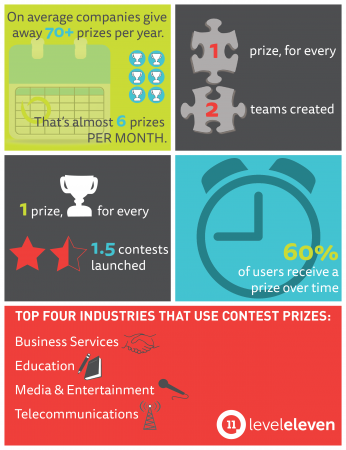As a data analyst here at LevelEleven, I surround myself with data points everyday. I’m a strong believer in the notion that answers can always be found in data. Thus, after reading so much lately about the power of sales incentives to drive key sales behaviors, I decided to take a look into our own data to see if what I was reading truly had validity.
I studied almost 300 of the organizations we work with, which vary in size and industry, from startup technology companies to enterprise media companies and everything in between. In particular, I looked at their use of incentives with sales contests.
Here are the most interesting sales incentive insights that I found:

1. Over the course of a year, companies on average gave away 71 sales incentives attached to contests. That’s almost 6 prizes per month and 1 prize per 1.5 contests.
At first, this surprised me. The average company gives away six prizes per month? 1 prize every 1.5 contests?
However, the more I thought about it, the more it made sense. Many of these organizations know that shorter motivation campaigns tend to be more engaging, so they abide by this best practice. Even those organizations offering longer contests around things like quarterly quota tend to break them up into shorter contests along the way so participants don’t lose interest.
When giving away prizes, think of more frequent contests with smaller incentives rather than giving away one big incentive at the end of a quarter.
2. For every two sales contest teams created, one sales incentive is given away.
Companies have embraced what I like to call the rivalry mentality. Whether it be different cities or different employee roles, companies have come to realize that creating two teams and pairing them against each other seems to be the winning formula.
In the same way that two football teams compete in mid-February every year for the Super Bowl trophy, companies like to pit two teams against each other with the winner receiving some type of sales incentive. This not only rewards salespeople who perform well, but also promotes a sales culture of camaraderie and healthy competition.
3. 60% of salespeople receive prizes at some point.
This seems a bit high, doesn’t it? How can a majority of salespeople receive prizes?
Keep in mind that these incentives are meant to enhance the selling potential of each and every one of your sales members and not just a select few. Companies have recognized that a high-performing sales organization stems from satisfied and driven salespeople. This type of culture is developed when everyone feels innately motivated and appreciated for the work that they are doing.
Try to find ways to incentivize all demographics of salespeople. When all sales personnel, from top to bottom, are placed in positions where they have chances to succeed and receive prizes, KPIs are maximized and quotas are hit.
4. Top four industries using sales incentives currently: Business Services (consulting, research etc.), Education, Media & Entertainment, Telecommunications.
I wanted to see if certain industries had cultures where sales incentives were emphasized over others. To be honest, I was hoping to see a trend with more tech-heavy industries or industries with higher deal sizes, etc.
What I found was that the four leading industries where companies use sales incentives are as diverse as can be. This in itself proves a point, however. No company or industry is “more suited” for sales incentives than another. Every organization can benefit.
I challenge you to take a look at your sales structure, now knowing these insights, and see how you can try to creatively incorporate sales incentives. Over time, this focus will prove immensely beneficial in the form of more motivated salespeople, an improvement of company culture via camaraderie and competition and also an optimization of the KPIs necessary for team success.


